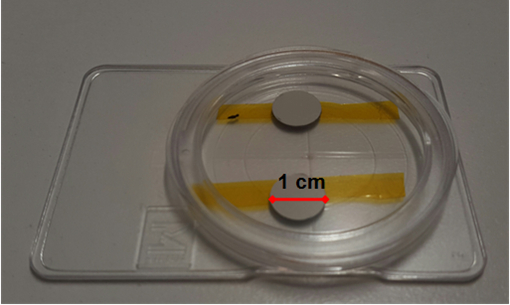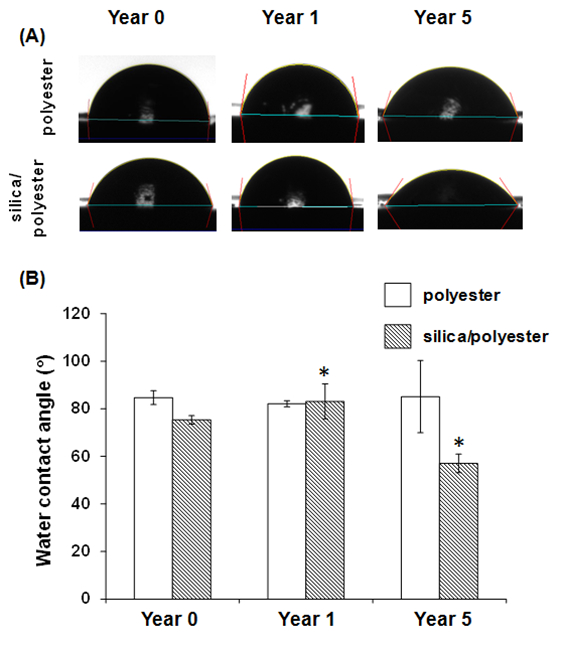このコンテンツを視聴するには、JoVE 購読が必要です。 サインイン又は無料トライアルを申し込む。
Method Article
日光への露出表面上にシリカナノ粒子 - ポリエステルコーティングの進化
要約
表面の2種類のシリカナノ粒子の層でコーティングされたポリエステル被覆鋼およびポリエステルを、調べました。両表面は、表面の化学的性質およびナノトポグラフィーでの実質的な変化を引き起こすことが見出された日光に暴露しました。
要約
金属表面の腐食は、環境中で流行していると、とりわけ軍事、輸送、航空、建物や食品産業など、多くの分野での大きな関心事です。ポリエステル及びシリカナノ粒子(SiO 2のNPS)の両方を含有するポリエステル及びコーティングは広く腐食から鋼基層を保護するために使用されてきました。本研究では、X線光電子分光法、減衰全反射赤外線マイクロ分光法、水接触角測定、光学プロファイリングおよび原子間力顕微鏡は、日光への曝露は、マイクロおよびナノスケールの完全性の変化を引き起こすことができる方法への洞察を提供するために利用しましたコーティングの。表面マイクロトポグラフィーの有意な変化は、光学プロフィロメトリーを用いて検出されなかったが、表面に統計学的に有意なナノスケールの変化は、原子間力顕微鏡を用いて検出しました。 X線光電子分光法の分析と減衰全反射赤外線マイクロ分光分析データは、エステル基の分解はCOO・、H 2 C・、-O・、-CO・ラジカルを形成するために紫外線に暴露により生じたことを明らかにしました。分解プロセスの間に、CO及びCO 2も作製しました。
概要
Environmental corrosion of metals in the environment is both prevalent and costly1-3. A recent study conducted by the Australasian Corrosion Association (ACA) reported that corrosion of metals resulted in a yearly cost of $982 million, which was directly associated with the degradation of assets and infrastructure through metallic corrosion within the water industry4. From an international perspective, the World Corrosion Organization estimated that metallic corrosion was responsible for a direct cost of $3.3 trillion, over 3% of the world's GDP5. The process of galvanizing as a corrosion preventative method has been widely used to increase the lifespan of steel material6. In humid and subtropical climates, however, water tends to condense into small pockets or grooves within the surface of the galvanized steel, leading to the acceleration of corrosion rates through pit corrosion7,8. Thermosetting polymer coatings based on polyesters have been developed to coat the galvanized steel substrata increasing their ability to withstand humid weathering conditions for items such as satellite dishes, garden furniture, air-conditioning units or agricultural construction equipment9-11. Unfortunately polymer coatings on steel surfaces have been found to be considerably adversely affected by the presence of high levels of ultraviolet (uv) radiation12-14. Coatings comprised of silica nanoparticles (SiO2) spread over a polymer layer have been widely used with a view to increasing their corrosion-, wear-, tear- and degradation-resistance15,16. The tendency of the protective polymeric coatings to form pores and cracks can be reduced by incorporating nanoparticles (NPs), which contribute to the passive obstruction of corrosion initiation17,18. Also, the mechanical stability of the protective polymeric layer can be improved by NPs inclusion. However, these coatings act as passive physical barriers and, in comparison to the galvanization approach, cannot inhibit corrosion propagation actively.
An in-depth understanding of the effect that high-levels of ultraviolet light exposure under humid conditions upon these metal coatings is yet to be obtained. In this paper, a wide range of surface analytical techniques, including X-ray photoelectron spectroscopy (XPS), attenuated total reflection infrared micro-spectroscopy (ATR IR), contact angle goniometry, optical profiling and atomic force microscopy (AFM) will be employed to examine the changes in the surface of steel coatings prepared from polyester- and silica nanoparticle-coated polyester (silica nanoparticles/polyester) after exposure to sunlight. Furthermore, the aim of this work is to give a concise, practical overview of the overall characterization techniques to examine weathered samples.
プロトコル
1.鋼試料
- 商業的供給業者から厚さ1mmの鋼試料を得ます。
注:サンプルは、シリカナノ粒子でコーティングされたポリエステルまたはポリエステルのいずれかでコーティングしました。 - ロックハンプトン、クイーンズランド州、オーストラリアでの太陽光にサンプルを公開:合計5年間で1年と5年の間隔後のサンプルを収集します。穴パンチャーを使用して、直径1cmの丸い円盤状にサンプルパネルをカットします。
- 、特性表面ダブル蒸留水で試料を洗浄した後、窒素ガス(99.99%)を用いて乾燥する前に。表面( 図1)に吸着する任意の空気汚染物質を防止するために気密容器内のすべてのサンプルを保管してください。

ポリエステルベースのコーティングを有する金属ディスクの作製図。必要になるまで、試料を容器に貯蔵しました。オム/ファイル/ ftp_upload / 54309 / 54309fig1large.jpg "ターゲット=" _空白 ">この図の拡大版をご覧になるにはこちらをクリックしてください。
表面の2化学と物理化学的特性評価
- X線光電子分光法を用いて表面の化学的性質を分析します。
- X線光電子分光法(XPS)150 W.で動作する単色X線源(アルKα、hνを= 1486.6 eVの)を使用してを実行します
注:使用X線ビームのスポットサイズは、直径が400μmです。 - サンプルプレート上の負荷サンプル。その後、チャンバーをポンプXPSの真空チャンバ内にサンプルプレートを置きます。 〜1×10 -9ミリバールに到達するために、チャンバ内の真空を待ちます。
- 光電子分光法ソフトウェアでは、表面の帯電を打ち消すために、低エネルギー電子でサンプルをフラッディングする「フラッドガン」のオプションを押してください。
- プレス分析POINを挿入するには> "ポイント">「ポイント」を「挿入」トン。
注:これは、分析が実行される場所です。取得のための最高の高さを得るために、自動高機能を有効にします。 - 押して "挿入"> "スペクトラム"> "マルチスペクトル」は、この点にスキャンを追加します。
注:これは、周期表でウィンドウを開きます。それを強調表示し、それをクリックすることで、要素を選択します。 - 実験を設定した後、スキャンを続行する「再生」コマンドを押してください。
- 押して「ピークフィット」コマンドは、その後、「ピークを追加」と「すべてのレベルを合わせる「高分解能スペクトルの化学的に異なる種を解決するために、コマンドキーを押します。
注:この手順は、スペクトル19をデコンボリューションするフィッティング背景とガウスローレンツを削除するには、シャーリーアルゴリズムを取得します。 - すべての高解像度を選択して、スペクトルを調査。 hydrocaを使用してスペクトルを修正するために押して「電荷シフト」オプション基準として、C 1sのピーク(結合エネルギー285.0 eV)でのrbonコンポーネント。
- 充電補正後、プレス機「エクスポート」オプションは、ピーク面積に基づいて、要素の相対原子濃度のデータテーブルを生成します。
- X線光電子分光法(XPS)150 W.で動作する単色X線源(アルKα、hνを= 1486.6 eVの)を使用してを実行します
- 界面化学
注:次のようにオーストラリアのシンクロトロンの赤外線(IR)分光ビームライン上に減衰全反射赤外マイクロ分光法(ATR-IR)を用いて表面の化学的性質を分析します。- 顕微鏡のステージ上の負荷サンプル。 「スタートビデオ支援測定」または「スタート測定3Dなし」オプションを開きます。 「VIS」モードをオンにします。試料表面に集中する目的に使用します。所望の画像を取るために押して、「スナップショット/概要」を参照してください。
注:厚さ0.5mmのCaF 2プレートは、バックグラウンドとして使用することができます。 - サンプルにATRの目標を変更します。慎重に45°の多重反射のGERを配置するために、ステージを移動させますmanium結晶表面上記1〜2ミリメートル(4の屈折率)。ライブビデオウィンドウを右クリックします。押して「測定開始」>「変更測定パラメータ」。オプション "すべてのポジションのために既存のBGは絶対に使用しないでください」を選択します。
注:これは、すべての測定点のためのバックグラウンドスペクトルを取るしないことを選択します。 - 関心領域を選択するためにビデオ画面上の地図を描きます。赤い絞りの正方形を押し、 "絞り"> "変更絞り値」を選択します。 X = 20μmであり、Y =20μmと実際の「ナイフエッジ絞り」の設定を変更します。
- 新しいサイズの開口広場に右クリックし、 "絞り"に行く>」を選択した開口部に、すべての開口部を設定します」。押して「測定」アイコンは、スキャンを開始します。データを保存します。
注:Ge結晶の屈折率は4であるため、20ミクロン×20μmの開口を5μm×5μmのスポットサイズを定義します。ティsのステップは、4,000-850センチの最大波数範囲にわたって結晶中を5μmのスポットにより5ミクロンに相当する20ミクロン20の開口部、とFTIRマッピングを設定することができます- 1。 - 分光ソフトウェアを使用してオープンマスターファイル。 IRスペクトル上の目的のピークを選択してください。関心のピークを右クリックします。 「統合」>「統合」を選択します。これは、2D偽色マップを作成できるようになります
- 顕微鏡のステージ上の負荷サンプル。 「スタートビデオ支援測定」または「スタート測定3Dなし」オプションを開きます。 「VIS」モードをオンにします。試料表面に集中する目的に使用します。所望の画像を取るために押して、「スナップショット/概要」を参照してください。
- 表面の濡れ性測定
注:ナノディスペンサー19を搭載した接触角ゴニオメーターを使用して濡れ性測定を行います。- ステージ上にサンプルを置きます。針の底がダウンライブビデオウィンドウ画面内の道の約1/4表示されるように、マイクロアセンブリの位置を調整します。
- 試料と表面との間の距離は約5mmになるまで、z軸を使用してサンプルを上げます。 DOUBの液滴まで注射器を下に移動ル蒸留水は、表面に触れます。元の位置に注射器を上に移動します。
- ハードウェアと一体化されたモノクロCCDカメラを使用して、20秒の期間のための表面に衝突する水滴を記録するために、「ファイル名を指定して実行」コマンドを押してください。
- 一連の画像を取得するための「停止」コマンドを押してください。
- プレス「接触角」は、取得した画像から接触角を測定するコマンド。各サンプルのための3つのランダムな位置で接触角測定を繰り返します。
表面形状の3可視化
- 光学プロファイリング測定。
注:この機器は、白色光垂直走査干渉モードで運転されます。- 顕微鏡のステージ上にサンプルを置きます。
注:対物レンズとステージとの間に十分な隙間( 例えば 、> 15ミリメートル)があることを確認してください。 - 使用して表面に焦点を合わせます縞が画面に表示されるまで、z軸を制御することにより、5×目標。押して「オート」コマンドは、強度を最適化することができます。押して「測定」コマンドでは、スキャンを開始します。マスターファイルを保存します。
- 20×50×目的のためのステップ3.1.2を繰り返します。
- 統計粗さの前には、表面うねりを除去するために押して「チルトを削除」オプションを分析します。押して「輪郭」オプションでは、粗さのパラメータを分析します。互換性のあるソフトウェア20を用いた光プロファイリング・ファイルの3次元画像を生成するために、「3Di社」オプションをクリックします。
- 顕微鏡のステージ上にサンプルを置きます。
- 原子間力顕微鏡法
- スチールディスクにサンプルを置きます。磁気ホルダーに鋼製のディスクを挿入します。
- モード21をタッピングでAFMスキャンを実行します。機械的負荷のリンを0.9 N / mのバネ定数、8ナノメートルの半径、表面イメージングのための約20キロヘルツの共振周波数を有する先端曲率を有するシリコンプローブをドープされます。 <李>は手動でカンチレバーにレーザー反射を調整します。メーカーによって報告された最適な共振周波数に到達するために調整するためにAFMカンチレバーを「チューニング」コマンドを押して「オートチューン」コマンドを選択します。
- 表面に焦点を当てています。試料表面に近いヒントを移動します。表面のAFMチップに係合するようにエンゲージコマンドをクリックします。
- 走査速度ボックスに「1ヘルツ」と入力します。走査領域を選択してください。押して「ファイル名を指定して実行」は、スキャンを実行するコマンド。各条件の5つのサンプルのそれぞれの10領域について、少なくともスキャンを繰り返します。
- 結果の地形図データを処理するためのレベリングオプションを選択します。マスターファイルを保存します。
- 互換性のAFMソフトウェアを開きます。 AFMのマスターファイルをロードします。押して「平準化」とは、表面の傾斜を除去するためのコマンド。背景を削除するを押して「スムーズ」コマンド。
- 統計的な粗さ21を生成するために押して「統計パラメータ解析」。
4.統計解析
- 平均値とその標準偏差の点で結果を表現します。結果の一貫性を評価するために、対になった学生の両側のt-検定を用いて統計的なデータ処理を行います。統計的有意性のレベルを示す<0.05のp -値を設定します。
結果
一方又は5年間、日光への曝露に供された被覆された鋼試料を採取し、水接触角測定は、露光面の表面疎水性の変化が生じたかどうかを決定するために実施した( 図2 )。

日光への暴露の5年間ポリエステルまたはシリカのナノ粒子/ポリエステルコーティングを有する表面?...
ディスカッション
ポリエステルコーティングが広く水分及び汚染物質の蓄積にコーティングされていない表面に生じる腐食から鋼基層を保護するために使用されてきました。ポリエステルコーティングの適用は、腐食から鋼を保護することができます。それらは多湿条件下で紫外線の高レベルにさらされた場合、熱帯気候で発生しかしながらこれらのコーティングの長期の有効性が、損なわれる。シリカナノ?...
開示事項
The authors have nothing to disclose.
謝辞
Funding from the Australian Research Council Industrial Transformation Research Hubs Scheme (Project Number IH130100017) is gratefully acknowledged. Authors gratefully acknowledge the RMIT Microscopy and Microanalysis Facility (RMMF) for providing access to the characterisation instruments. This research was also undertaken on the Infrared Microscopectroscopy beamline at the Australian Synchrotron, Victoria, Australia.
資料
| Name | Company | Catalog Number | Comments |
| polyester-coated steel silica nanoparticle-polyester coated steel substrata | BlueScope Steel | Samples provided by company | |
| Millipore PetriSlideTM | Fisher Scientific | PDMA04700 | Storing samples |
| Thermo ScientificTM K-alpha X-ray Photoelectron Spectrometer | Thermo Fisher Scientific, Inc. | IQLAADGAAFFACVMAHV | Acquire XPS spectra |
| Avantage Data System | Thermo Fisher Scientific, Inc. | IQLAADGACKFAKRMAVI | Analyse XPS spectra |
| A Bruker Hyperion 2000 microscope | Bruker Corporation | Synchrotron integrated instrument | |
| Bruker Opus v. 7.2 | Bruker Corporation | ATR-IR analysis software | |
| Contact angle goniometer, FTA1000c | First Ten Ångstroms Inc., VA, USA | Measuring the wettability of surfaces | |
| FTA v. 2.0 | First Ten Ångstroms Inc., VA, USA | Anaylyzing water contact angle | |
| Optical profiler, Wyko NT1100 | Bruker Corporation | Measure surface topography | |
| Innova atomic force microscope | Bruker Corporation | Measure surface topography | |
| Phosphorus doped silicon probes, MPP-31120-10 | Bruker Corporation | AFM probes | |
| Gwyddion software | http://gwyddion.net/ | Software used to measure optical profiling and AFM data |
参考文献
- Fathima Sabirneeza, A. A., Geethanjali, R., Subhashini, S. Polymeric corrosion inhibitors for iron and its alloys: A review. Chem. Eng. Commun. 202 (2), 232-244 (2015).
- Gupta, R. K., Birbilis, N. The influence of nanocrystalline structure and processing route on corrosion of stainless steel: A review. Corros. Sci. 92, 1-15 (2015).
- Lee, H. S., Ismail, M. A., Choe, H. B. Arc thermal metal spray for the protection of steel structures: An overview. Corros. Rev. 33 (1-2), 31-61 (2015).
- Moore, G. . Corrosion challenges - urban water industry. , (2010).
- Hays, G. F. . World Corrosion Organization. , (2013).
- Koch, G. H., Brongers, M. P. H., Thompson, N. G., Virmani, P. Y., Payer, J. H. Corrosion cost and preventive strategies in the United States. CC Technologies Laboratories, Incorporated; NACE International; Federal Highway Administration, NACE International. , (2002).
- Pojtanabuntoeng, T., Singer, M., Nesic, S. . Corrosion 2011. , (2011).
- Jas̈niok, T., Jas̈niok, M., Tracz, T., Hager, I. . 7th Scientific-Technical Conference on Material Problems in Civil Engineering, MATBUD 2015. , 316-323 (2015).
- Cambier, S. M., Posner, R., Frankel, G. S. Coating and interface degradation of coated steel, Part 1: Field exposure. Electrochim. Acta. 133, 30-39 (2014).
- Barletta, M., Gisario, A., Puopolo, M., Vesco, S. Scratch, wear and corrosion resistant organic inorganic hybrid materials for metals protection and barrier. Mater. Des. 69, 130-140 (2015).
- Fu, J., et al. Experimental and theoretical study on the inhibition performances of quinoxaline and its derivatives for the corrosion of mild steel in hydrochloric acid. Ind. Eng. Chem. Res. 51 (18), 6377-6386 (2012).
- Hattori, M., Nishikata, A., Tsuru, T. EIS study on degradation of polymer-coated steel under ultraviolet radiation. Corros. Sci. 52 (6), 2080-2087 (2010).
- Yang, X. F., et al. Weathering degradation of a polyurethane coating. Polym. Degrad. Stab. 74 (2), 341-351 (2001).
- Armstrong, R. D., Jenkins, A. T. A., Johnson, B. W. An investigation into the uv breakdown of thermoset polyester coatings using impedance spectroscopy. Corros. Sci. 37 (10), 1615-1625 (1995).
- Zhou, W., Liu, M., Chen, N., Sun, X. Corrosion properties of sol-gel silica coatings on phosphated carbon steel in sodium chloride solution. J. Sol. Gel. Sci. Technol. 76 (2), 358-371 (2015).
- Hollamby, M. J., et al. Hybrid polyester coating incorporating functionalized mesoporous carriers for the holistic protection of steel surfaces. Adv. Mater. 23 (11), 1361-1365 (2011).
- Borisova, D., Möhwald, H., Shchukin, D. G. Mesoporous silica nanoparticles for active corrosion protection. ACS Nano. 5 (3), 1939-1946 (2011).
- Wang, M., Liu, M., Fu, J. An intelligent anticorrosion coating based on pH-responsive smart nanocontainers fabricated via a facile method for protection of carbon steel. J. Mater. Chem. A. 3 (12), 6423-6431 (2015).
- Truong, V. K., et al. The influence of nano-scale surface roughness on bacterial adhesion to ultrafine-grained titanium. Biomaterials. 31 (13), 3674-3683 (2010).
- Nečas, D., Klapetek, P. Gwyddion: An open-source software for SPM data analysis. Cent. Eur. J. Phys. 10 (1), 181-188 (2012).
- Crawford, R. J., Webb, H. K., Truong, V. K., Hasan, J., Ivanova, E. P. Surface topographical factors influencing bacterial attachment. Adv. Colloid Interface Sci. 179-182, 142-149 (2012).
- Allen, N. S., Edge, M., Mohammadian, M., Jones, K. Physicochemical aspects of the environmental degradation of poly(ethylene terephthalate). Polym. Degrad. Stab. 43 (2), 229-237 (1994).
- Newman, C. R., Forciniti, D. Modeling the ultraviolet photodegradation of rigid polyurethane foams. Ind. Eng. Chem. Res. 40 (15), 3346-3352 (2001).
- Ivanova, E. P., et al. Vibrio fischeri and Escherichia coli adhesion tendencies towards photolithographically modified nanosmooth poly (tert-butyl methacrylate) polymer surfaces. Nanotechnol. Sci. Appl. 1, 33-44 (2008).
- Biggs, S., Lukey, C. A., Spinks, G. M., Yau, S. T. An atomic force microscopy study of weathering of polyester/melamine paint surfaces. Prog. Org. Coat. 42 (1-2), 49-58 (2001).
- Signor, A. W., VanLandingham, M. R., Chin, J. W. Effects of ultraviolet radiation exposure on vinyl ester resins: Characterization of chemical, physical and mechanical damage. Polym. Degrad. Stab. 79 (2), 359-368 (2003).
- Wang, H., et al. Corrosion-resistance, robust and wear-durable highly amphiphobic polymer based composite coating via a simple spraying approach. Prog. Org. Coat. 82, 74-80 (2015).
- Liszka, B. M., Lenferink, A. T. M., Witkamp, G. J., Otto, C. Raman micro-spectroscopy for quantitative thickness measurement of nanometer thin polymer films. J. Raman Spectrosc. 46 (12), 1230-1234 (2015).
- Alghunaim, A., Kirdponpattara, S., Newby, B. M. Z. Techniques for determining contact angle and wettability of powders. Powder Technol. 287, 201-215 (2016).
- Treviño, M., et al. Erosive wear of plasma electrolytic oxidation layers on aluminium alloy 6061. Wear. 301 (1-2), 434-441 (2013).
転載および許可
このJoVE論文のテキスト又は図を再利用するための許可を申請します
許可を申請さらに記事を探す
This article has been published
Video Coming Soon
Copyright © 2023 MyJoVE Corporation. All rights reserved